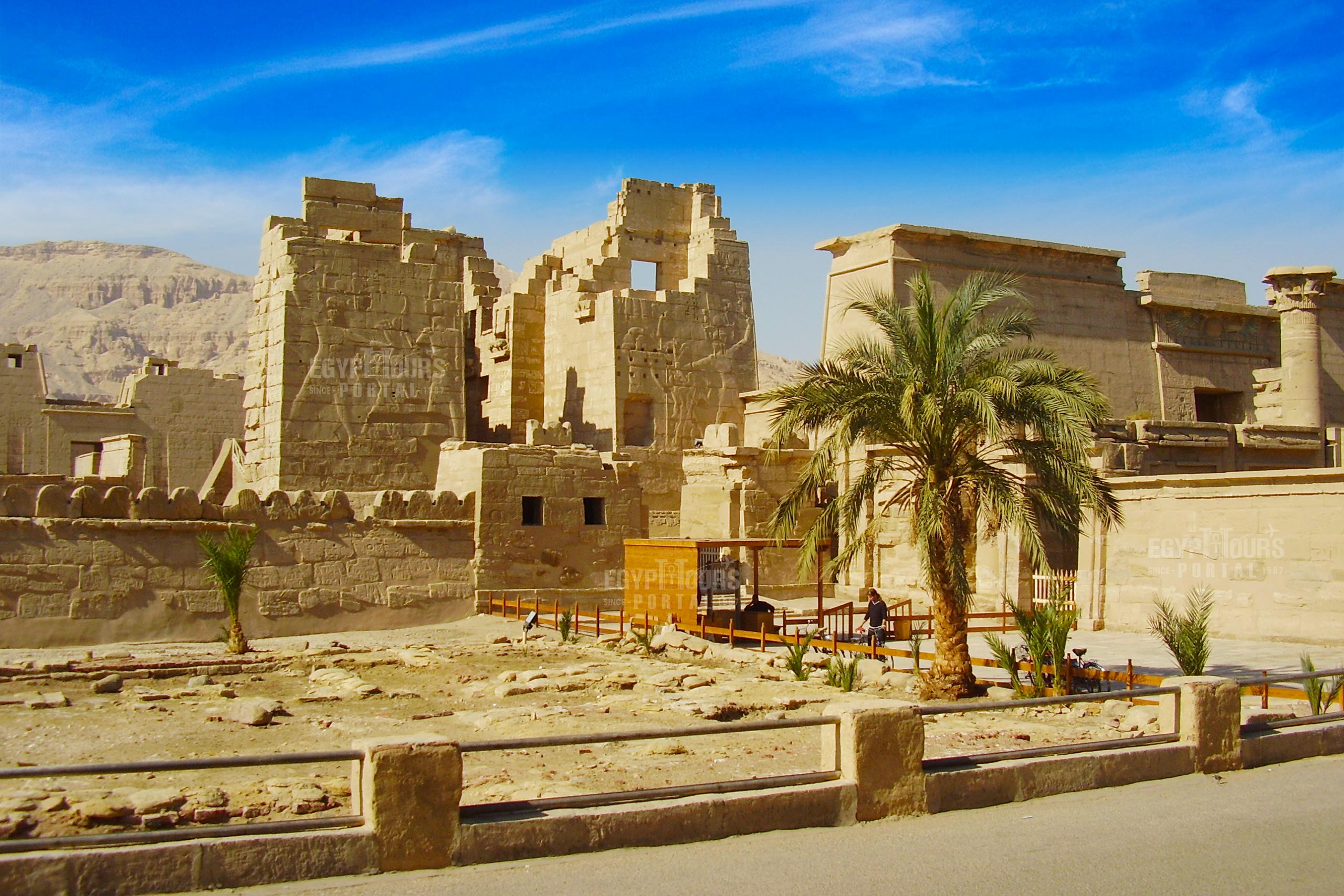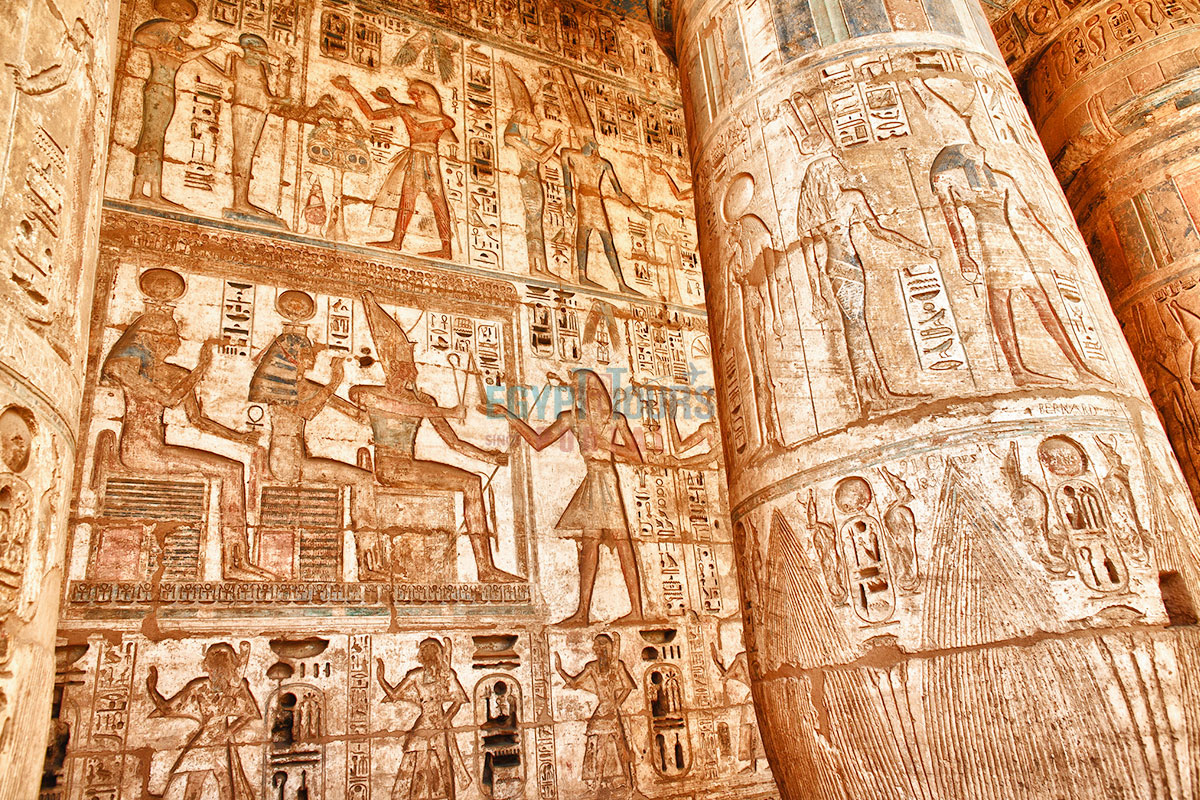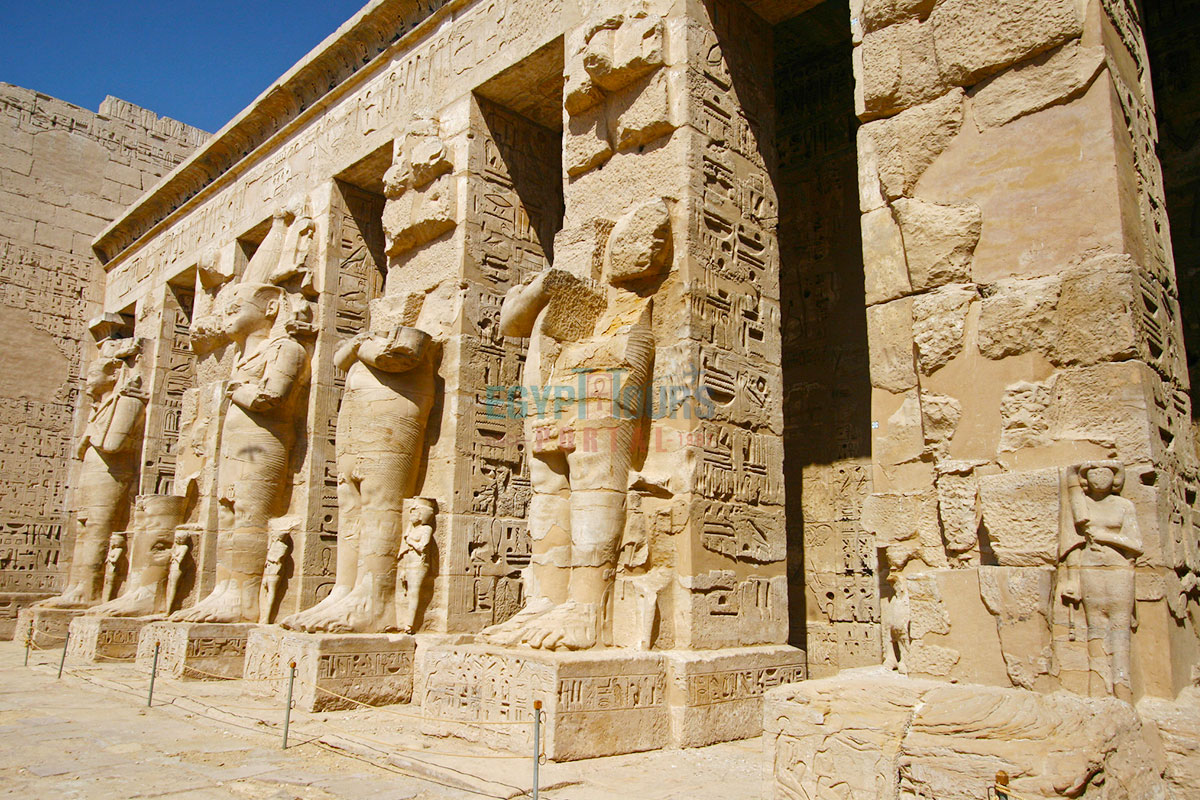- Local Time: 10:50 AM
- Weather: 28 ℃ / 83 ℉

The historical and cultural wealth of Ancient Egypt is infinite, able to take travelers from all over the world on a magical journey through time more than 3500 years ago. It is considered to be one of the most captivating monuments to explore in the heavenly city of Luxor, famous for its highly preserved carvings, reliefs, and statues.
This ancient mortuary temple of Ramses III was able to stand the test of time and preserve some of the most enchanting collections of Artifacts and monuments ever built. This majestic temple holds many great scenes of allure and grandeur worthy of exploring.

Medinat Habu was built during the New Kingdom (1570 – 1050 BC) by Ramsess III (1184 – 1153 BC) the second Pharaoh of the 20th dynasty Medinet Habu was for centuries the center of the economic life of Thebes. The oldest construction on the site was an eleven dynasty (2081 – 1938 BC) small shrine that was later enlarged by Thutmose III and Hatshepsut to honor the creator god Amon and the Primeval Ogdoad which is an Eight Deities from the Middle Kingdom.
It was abandoned in the 3rd intermediate period (1075 – 656 BC) and acted as a private cemetery. The temple held a row of funerary chapels to the so-called wives of Amun during the 20th, 25th, 26th, 29th, and 30th Dynasties plus in the same dynasties and the Greco-Roman were a number of various modifications and alterations.

Many may wonder why is the Medinet Habu important and what was Medinat Habu used for, and the answer is that The archaeological wonder of Medinet Habu is a fortified construction that was a highly important religious center dedicated to the God Amun and a Pharaonic power base within western Egypt.
It was used in times of conflict for protection for the western inhabitants of Thebes and as a center for Dayr al-Madinah women's village. The complex was also a walled and fortified town for the Coptic Christians in the 9th century AD. It was designed to display military might and celebrate victory in battles against the sea people, Libyans, and Nubians.

It is the second biggest ancient temple ever constructed on an area of 66,000 square meters on the west bank of the Nile River at the feet of the Theban Hills in the opposite city of Luxor. The Temple measures 200 m in width from the north to the south and 320 m in length from the east to the west.
It is one of the most underrated attractions in Thebes containing a number of temples, workshops, storage rooms, a royal palace, administrative buildings, and accommodations for officials and priests. It is one of the largest memorial temples in all of Egypt and contains between its gates the temple of Amun, The temple of Ramesses III, and the temple of Ay & Horemheb. It has many courtyards with very columns and reliefs that contain the finest and highly intact coloring that lead to a majestic hypostyle hall.

The entire construction is made up of a massive gate in the design of a Syrian fort which is decorated and carved with many battle scenes showcasing Ramsess III's war with the Syrians. Behind the gate is an incredible shrine that dates back all the way to the 18th dynasty. The temple was a wide-open court that leads directly to a massive pylon with both of the towers that are decorated with battle scenes such as the king wearing a red crown with the KA, while he is defeating his enemies in presence of Re-Horakhty and another with the king wearing lower Egypt red crown which smiting his enemies in the presence of Amun-Ra. On the southern tower is an engraved scene of an Oxen Hunt with Ramses II riding his chariot.
The first open court is about 33m wide by 42m long and is decorated with many battle scenes of a war between the Egyptians and the Syrians & Libyans. The second courtyard is about 38m wide by 42m long that holds a small lake plus it became a basilica in the early Christian era filled with scenes of religious ceremonies like the festival and min and Sokar plus other scenes with many holy priests and kings providing offerings to the ancient Egyptian gods.
The first Hypostyle was rocked by an earthquake in 27 BC which once held 24 columns divided into six rows plus surrounded by 16 chapels. Some of the most significant shrines in the temple are the one dedicated to King Ramses III, the second dedicated to Ptah, chapel number four is consecrated for the Sokker Boat, and the seventh chapel dedicated to a sacred boat of Amun-Ra. The chapels on the left side are where the utensils of the temple are stored, chapel number 14 that are dedicated to the divine boat of Pharaoh Ramses II, and chapel number 15 is dedicated to the sacred boat of Montho. The 2nd hypostyle hall contains eight papyrus columns in two rows while the ceiling is supported by eight columns in two rows. The Hypostyle hall has an end that possesses three entrances the entrance in the center leads to the sanctuary that is dedicated to the Theban triad where Amun-Ra sacred boat is found, the chapel of god Khonsu on one the left side leads to the chapel of Mut.

The orthodox design of Ramesses III resembles the Ramesseum, It is about 490 ft (150 m) and is highly preserved, and is surrounded by a huge fortified mudbrick enclosure. The temple has many Chapels of Shepenupet II, Amenirdis I, and Nitiqret, which all of which possess the title of Divine Adoratrice of Amun.
The first pylon leads to a great open courtyard filled with colossal statues of Ramesses III as Osiris plus the second pylon leads to a peristyle hall that features Ramses III's dedicated columns.
The land of Thebes is the world’s greatest open-air museum filled with the finest examples of ancient architecture showcasing the greatest monuments ever created in the history of mankind, offering a gate to the legendary history of the New Kingdom. Luxor tours offer visitors the opportunity to explore the ancient city of Luxor in Egypt. Don't miss out on the opportunity to explore the rich history and culture of Luxor. Book your tour today and experience the wonders of the ancient city for yourself!"
Day Trip from Luxor to Cairo by Plane For British Travelers Day trip from Luxor to Cairo by plane is a ...
Tour to Luxor West Bank For British Travelers Tour to Luxor West Bank for British travelers is like step...
Tour to Edfu and Kom Ombo For British Travelers Edfu & Kom Ombo Tour from Luxor is a gateway to a n...
Trip to Dandara and Abydos from Luxor for British Travelers A Trip to Dandara and Abydos is a trip to tw...
Egypt Tours Portal prides itself on being the best travel agency in Egypt as proven by our numerous positive reviews.
This review is a late, but I had to provide some feedback. My brother and I went on vacation in October 2022 and booked with Egypt Tours Portal. With on-line sc...Read More
My fiancé and I booked a private 5 day tour of Egypt with ETP starting in Cairo followed by Aswan, Abu Simbel and Luxor. We just got home and continue to talk ...Read More
This was the trip of a lifetime that I was able to have with my eldest son - an absolutely amazing experience. To be able to actually see the places and artifac...Read More
Highly recommend this tour company!!! Our guides, Moses, Mahmoud, Magred and Mohamed were exceptional, their knowledge of the history is more that accurate, the...Read More
Egypt Tours Portal is an excellent company to use to arrange your visit to Egypt. They work with phenomenal guides (we had Mahmoud Nour in Upper Egypt and Mohse...Read More
It was an absolutely amazing trip where we saw some of the most historical and beautiful sights in Egypt. Our tour guide Mohamed Elshemei was extremely knowledg...Read More








